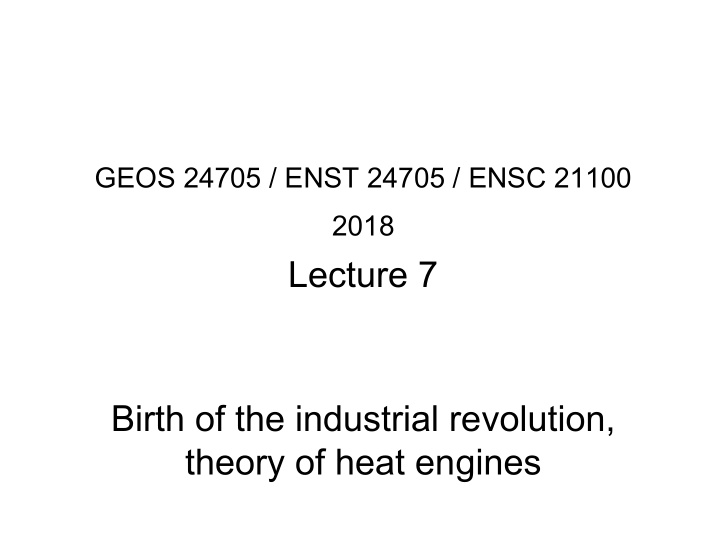



GEOS 24705 / ENST 24705 / ENSC 21100 2018 Lecture 7 Birth of the industrial revolution, theory of heat engines
EvoluCon of human use of power in Britain Braudel: pre-modern usage was ~ 70 W work, ~ 1000 W primary power Steam by 1800 adds another ~ 10 W work (~600 W input) Steam by 1825 adds about ~40 W work (~1200 W input, doubles) In 1800 U.K., steam is less than wind + water, but by 1825 exceeds it growth in efficiency means that work output rises faster than primary power
Industrial RevoluCon isn’t Ced simply to heat engine evoluCon Industrial Industrial Revolu0on Revolu0on from V. Smil starts when heat engines are negligible in the U.K. other than for mine pumping
EsCmates of early energy use are broadly consistent 100.0 All France 1800-2011 U.S. note: one data point Norway Netherlands 1800-2011 USA Switzerland Netherlands Ireland Austria Canada per 5 years Fl 1949 Sweden Australia Germany Belgium UK Denmark Finland Japan U.K. 1800-2011 France Italy Spain SKorea Israel NewZealand Greece Portugal U.S. 1850-2011 Chile Argentina GDP PPP ($1000) Turkey LebanonMalaysia Mexico CostaRica 10.0 Brazil Colombia Tunisia Peru DominicanRepublic Thailand Ecuador ElSalvador Jordan Syria SriLanka Guatemala Bolivia Morocco Paraguay Indonesia Honduras Philippines India Vietnam Nicaragua Pakistan Cambodia Bangladesh Haiti Nepal 1.0 $9/yr/W $3/yr/W Data: World Bank, ~1960-2011 2005 USD pre 1800 1825 0.1 www.energyhistory.org, converted to 2005 USD 0.1 1.0 10.0 Power use per capita (1000 W) U.S. data from EIA
Duty maQered – coal was a cost 1781, Wa6 licenses technology with payment based on coal savings: “...the Coalbrookdale partners decided to supersede the Newcomen engines in the works at Coalbrookdale and at Ketley, by engines on the plans of James WaQ. It was found that the Newcomen engine in Coalbrookdale consumed 12 tons of small coal, valued at 2s. 6d. per ton, beyond what would be required for every 10,000 strokes by a WaQ engine having a cylinder 66 inches in diameter and 11 feet long, making 9 strokes a minute. It was agreed therefore, in 1781, to pay to Boulton and WaQ one-third of the esCmated savings in fuel upon this basis, or 10 s. for every 10,000 strokes, as recorded by a mechanical counter, during the unexpired porCon of the term of WaQ’s renewed patent.” Davey, “The Newcomen Engine”, Proc. of the Inst. of Mech. Eng. , 1903
Why didn’t engineers give “duty” as a dimensionless efficiency? “duty” = work done per coal used why not make it energy per energy? because they didn’t know that work and heat were equivalent
Heat engine development: pracCce leads theory Newcomen’s 1712 engine comes before we can even measure temperature Fahrenheit’s mercury thermometer is developed only 1714, Celsius scale later No one asserts equivalence of heat and work Cl 1790s (Rumford cannon-boring) SCll arguing over equivalence in the 1820s (Carnot) More asserCons of equivalence in the 1840s: Von Mayer, Joule, Colding No exact measure of heat-work equivalence unCl Joule in 1845 No firm understanding of what heat is Cl 1850 (Clausius, also first idea of entropy) Thermodynamics we would recognize: “The Theory of Heat” 1871 (Maxwell) Newcomen, 1712 Joule, 1845
Use Newcomen engine to begin to understand heat engine physics Work = force x distance = pressure x volume from Mechanical Engineers, 1903
Indicator diagram tells you engine performance: work done per stroke Aston Vale Newcomen engine, built 1746-60, measured 1895 from Mechanical Engineers, 1903
Newcomen engine at Farme Colliery, built 1810, measured 1895, sCll working 1903
Double-acFon steam engine In this animaCon, instant switch from steam injecCon to exhaust slide valve alternates input & exhaust
Double-acFon steam engine Real engines cut off steam injecCon partway through stroke 1. Let steam into lej side of piston, exhaust from right 2. Piston moves to the right, both valves open 3. Lej valve closes, piston conCnues to move right
Cutoff valve reduces power but increases efficiency
Simplest possible external combus0on engine “SCrling engine” • no condensaCon, air as the working fluid • closed cycle – no exhaust • heat added on one side, other side cold • displacer moves air from hot to cold side of cylinder CYCLE • when air is on hot side, piston moves up • when air is on cold side, moves down
Recommend
More recommend